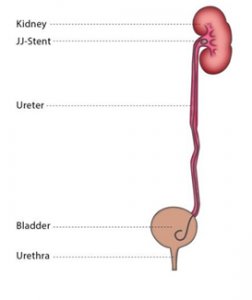How is a ureteric stent inserted?
What to expect after your stent insertion?
How long does the ureteric stent need to stay in place?
Daily activities with a ureteric stent in place:
Home care of your ureteric stent:
When to call your doctor?
What is a ureteric stent?

Ureteric Stent
A ureteric stent is a thin, hollow plastic tube that is inserted into the ureter (the tube that connects the bladder to the kidneys). The stent is
held in place by small coils at each end- one coil in the kidney and one
in the bladder.
The purpose of the ureteric stent is to bypass a blockage, which may
have been caused by a stone, narrowing of the ureter, swelling
following an operation, or another medical condition. Unblocking the
kidney allows for urine to flow more freely, preventing the build-up of
pressure that typically causes pain and can damage the kidney.
Having a ureteric stent in place can help to prevent infection and
permanent damage to your kidney.
A ureteric stent is temporary and will not stay in permanently.
Depending on the reason for the stent, it will generally be in place for
between 2-6 weeks.
How is a ureteric stent inserted?
The ureteric stent is inserted under general anaesthetic, often at the same time as another procedure (such as a ureteroscopy). A special telescope (cystoscope) is passed through the urethra, into the bladder, and then the stent is placed into the ureter and kidney via the opening of the ureter at the bladder. The position of the stent is then checked using an x-ray.
What to expect after your stent insertion?
Most patients will be aware of their stent, but generally will not experience any major problems.
Some patients will experience moderate side effects, and some may experience more severe side effects. In most cases, these side effects decrease over time.
It is important to remember that each person has a different tolerance level of discomfort, so please speak with your doctor if you feel that you are not coping well.
- Discomfort, irritation, pain or burning sensations when passing urine.
- The ureteric stent can irritate the bladder, causing you to feel the need to urinate more frequently or more urgently.
- Blood may be present in the urine. This may be worse following strenuous activity such as going to the gym, or lifting heavy bags, but usually can be cleared by drinking lots of fluids.
- Pain in the flank (side, kidney pain) on the side where the stent is, when passing urine. This is common and tolerable for most people.
- Very occasionally, women may experience episodes of incontinence. This is thought to be due to the presence of the stent causing mechanical irritation inside the bladder; this usually resolves once the stent is removed.
How long does the ureteric stent need to stay in place?
For most patients, the stent will need to remain in place until the obstruction is relieved, which depends on the nature of the obstruction. Usually this is for between 2-6 weeks, and sometimes longer, though your urologist will discuss your individual circumstances with you.
Stents are designed to be held in place by small coils, and they are flexible enough to withstand daily activities.
Removal of the stent is usually a quick procedure and it is performed under light sedation or local anaesthetic.
Daily activities with a ureteric stent in place:
Sports and physical activity
- You may continue your normal physical activities with your stent in place, so long as your underlying kidney condition allows you to
- You may experience some discomfort in the kidney area or blood in your urine, especially if the exercise is strenuous
Work
- You may continue to work normally with your stent in place
- If your work involves physical activity, you may experience more discomfort
- If your work involves digging, heavy lifting, carrying or climbing, you may need to avoid working until you receive clearance from your urologist. If you require a medical certificate for work, please let your doctor know.
Sex
- There are no restrictions on sexual intercourse due to the presence of the stent
- Few patients experience discomfort during sexual activities.
Home care of your ureteric stent:
- Drink plenty of fluids – at least 2L per day; this can help to ease the discomfort caused by the stent
- You may take paracetamol for pain relief if required.
When to call your doctor?
- If you have a fever, chills or severe pain around the kidney or bladder area
- If you have constant, unbearable pain
- If you are passing blood clots
- If you are unable to pass urine
